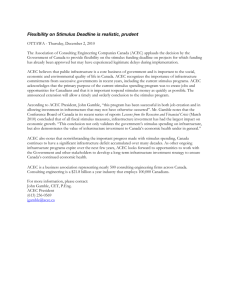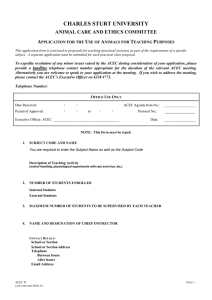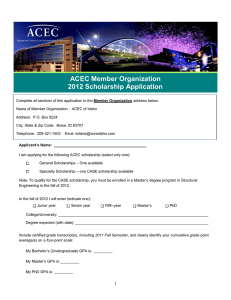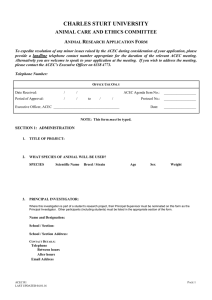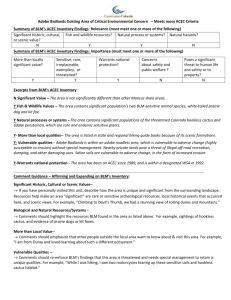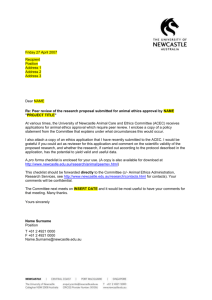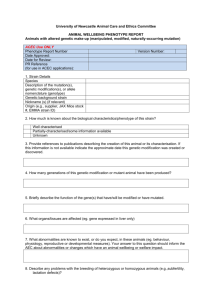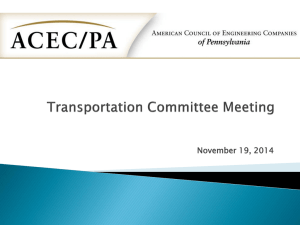ACEC-F1
advertisement
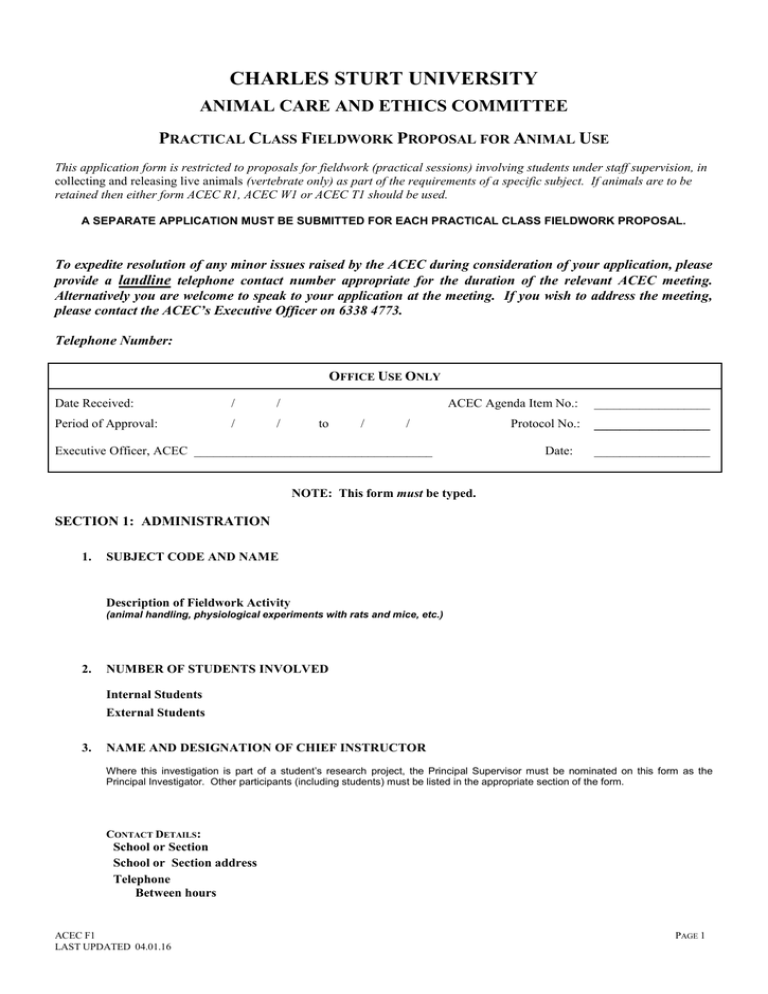
CHARLES STURT UNIVERSITY ANIMAL CARE AND ETHICS COMMITTEE PRACTICAL CLASS FIELDWORK PROPOSAL FOR ANIMAL USE This application form is restricted to proposals for fieldwork (practical sessions) involving students under staff supervision, in collecting and releasing live animals (vertebrate only) as part of the requirements of a specific subject. If animals are to be retained then either form ACEC R1, ACEC W1 or ACEC T1 should be used. A SEPARATE APPLICATION MUST BE SUBMITTED FOR EACH PRACTICAL CLASS FIELDWORK PROPOSAL. To expedite resolution of any minor issues raised by the ACEC during consideration of your application, please provide a landline telephone contact number appropriate for the duration of the relevant ACEC meeting. Alternatively you are welcome to speak to your application at the meeting. If you wish to address the meeting, please contact the ACEC’s Executive Officer on 6338 4773. Telephone Number: OFFICE USE ONLY Date Received: / / Period of Approval: / / to / ACEC Agenda Item No.: __________________ Protocol No.: __________________ / Executive Officer, ACEC _____________________________________ Date: __________________ NOTE: This form must be typed. SECTION 1: ADMINISTRATION 1. SUBJECT CODE AND NAME Description of Fieldwork Activity (animal handling, physiological experiments with rats and mice, etc.) 2. NUMBER OF STUDENTS INVOLVED Internal Students External Students 3. NAME AND DESIGNATION OF CHIEF INSTRUCTOR Where this investigation is part of a student’s research project, the Principal Supervisor must be nominated on this form as the Principal Investigator. Other participants (including students) must be listed in the appropriate section of the form. CONTACT DETAILS: School or Section School or Section address Telephone Between hours ACEC F1 LAST UPDATED 04.01.16 PAGE 1 After hours Email Address 4. SUPERVISORY PERSONNEL (INCLUDING UNIVERSITY ACADEMIC AND TECHNICAL STAFF) Please tell the Committee what experience the person has relevant to any procedure to be performed, and how many years’ experience in that field that nominee has. Position 5. Title Name Qualifications and Experience DATES FOR APPROVAL (Use DD/MM/YY format) From: To: For ongoing work where methodology does not change, you may apply for an approval period of up to three (3) years after the proposed commencement date, as the ACEC can approve ongoing projects for up to 3 years subject to receipt of annual reports (ACEC T2). Please note that Annual Review Forms are required under the Australian Code for the Care and Use of Animals for Scientific Purposes (2.4.34) 6. ANIMALS TO BE STUDIED If native mammals are to be the focus of the study, please identify the target species specifically, i.e., macropods, possums / gliders, native rats / mice, dasyurids, wombats, koalas, monotremes, bandicoots, bats, other. Please also be specific should any feral animal be the focus of the study. This will enable the ACEC to provide accurate data to the Department of Primary Industries each year in its annual report. SPECIES 7. Common Name Scientific Name NUMBER TO BE USED PER YEAR HAS AN APPLICATION BEEN MADE TO ANY OTHER ANIMAL ETHICS COMMITTEE TO CONDUCT THE SAME PROJECT, OR ANOTHER SUBSTANTIALLY SIMILAR? Choose one: Yes No ACEC F1 LAST UPDATED 04.01.16 PAGE 2 If YES, please indicate who the other Animal Ethics Committee is, and the name / nature of the project: 8. HAVE ANY ANIMALS TO BE USED IN THIS PROJECT BEEN THE SUBJECT OF PREVIOUS TEACHING PROGRAMS? Choose one: Yes No If YES, give identify which animals and the nature of the previous teaching work (i.e., spotlighting identification, trapping and release, etc.) 9. 10. LOCATION OF FIELDWORK STUDY (PLEASE PROVIDE SPECIFIC DETAILS): HAS PERMISSION BEEN GRANTED TO CAPTURE ANIMALS IN THE STUDY SITE? Choose one: Yes No If YES, please provide details. If NO, please explain why permission has not been granted: 11. A. ARE LICENCES REQUIRED? Choose one: Yes No If YES, do the Supervising staff have the appropriate licences? Choose one: Yes No If a current licence is not held and is required, then any approval will be subject to the ACEC being notified of receipt of a licence and advised of the type of licence, licence number and licence expiry date. The study may not commence without a licence. PROVIDE DETAILS Staff Member Type of Licence Licence Number Expiry Date B. HAVE ANY OF THE PEOPLE PARTICIPATING IN THE PROJECT HAD ANY ANIMAL RESEARCH AUTHORITY OR ANIMAL SUPPLIER’S LICENCE CANCELLED? Choose one: Yes No If YES, please provide details including the name of the person, the date on which the authority or licence was cancelled, who cancelled the authority and the reason for cancellation: Name of Staff Member ACEC F1 LAST UPDATED 04.01.16 Date Authority / Licence Cancelled Name of Cancelling Body Reason for Cancellation of Authority / Licence PAGE 3 SECTION 2: ANIMAL USE JUSTIFICATION FOR THE USE OF ANIMALS 12. JUSTIFICATION FOR NUMBER OF ANIMALS TO BE USED 13. JUSTIFICATION FOR USE OF ANIMALS IN TERMS OF BENEFIT TO THE TEACHING PROGRAM 14. WHAT NON-ANIMAL ALTERANTIVES HAVE BEEN CONSIDERED? EXPLAIN WHY THESE CANNOT BE USED IN PLACE OF ANIMALS. CAPTURE AND RELEASE Aspects may include handling, housing, etc., as well as specific procedures. Refer to the CHECKLIST at the end of this application form to ensure all details have been considered and refer to published Standard Operating Procedures where appropriate). 15. PLEASE PROVIDE DETAILS OF THE CAPTURE TECHNIQUES TO BE USED: All procedures must be in accordance with the Code of Practice prescribed in the Regulation and or / conditions imposed by the ACEC. Please list any Standard Operating Procedures which are to be used – please refer to the ACEC Register of Standard Operating Procedures on the ACEC website for a complete list of Standard Operating Procedures (SOPs) already approved by the Animal Care and Ethics Committee. If you are submitting a new Standard Operating Procedure for approval by the Committee, please insert “None- New for Approval” under “SOP Number”. SOP Number SOP Name 16. WILL STUDENTS BE INVOLVED IN CAPTURING ANIMALS? Choose one: Yes No 16. A. JUSTIFICATION FOR ALL TECHNIQUES / PROCEDURES WHICH HAVE THE POTENTIAL TO CAUSE PAIN OR DISTRESS ACEC F1 LAST UPDATED 04.01.16 PAGE 4 B. DETAIL STEPS TO BE TAKEN TO AVOID OR MINIMISE THE PAIN OR DISTRESS 17. EUTHANASIA OF ANIMALS IN CASE OF AN UNFORESEEN INJURY In the event of an unforeseen incident that requires euthanasia of an animal, I declare that this will be performed humanely by a registered veterinarian. If not, the alternative I propose is set out below: (A blank space below, with just a signature, will be taken as assent with this clause) ...................................................................................................................... Signature 18. WILL ANIMALS BE RELEASED AT THE END OF THE STUDY? Choose one: Yes No If NO, provide details explaining the fate of the animals. If live animals are to be retained, a separate application must be submitted on form ACEC R1 or ACEC T1. 19. ARE THERE ANY POTENTIAL HEALTH RISKS TO EITHER HUMANS, ANIMALS SURVIVING THE PROGRAM OR OTHER ANIMALS? Choose one: Yes No If YES, please describe the risk and what steps you have in place to protect the group at risk. 20. ARE THERE ANY FEATURES OF THE PROPOSAL WHICH RAISE SPECIAL ETHICAL CONSIDERATION? Choose one: Yes No If YES, give details. DECLARATION OF RESPONSIBILITIES A. Declaration by Subject Co-Ordinator I certify that the use of animals in this project will conform with the NSW legislation and the general principles of the NHMRC / CSIRO / ARC / AVCC Australian Code for the Care and Use of Animals for Scientific Purposes. I accept responsibility for the conduct of all procedures detailed in this application and for the supervision of all personnel delegated to perform any such procedures and understand it is an offence to conduct experiments unless approval in writing from the University’s Animal Care and Ethics Committee (ACEC) has been received. ACEC F1 LAST UPDATED 04.01.16 PAGE 5 I confirm that all supervisory personnel have read this application and have agreed to comply with procedures described and any conditions imposed by the ACEC. I confirm that I have taken into account potential hazards to staff working with animals in this project, and have ensured that appropriate safety measures have been implemented. Subject Co-Ordinator:____________________________________ (Signature) Date: ____________________ (Print Name) B. Declaration by Head of School / Section (as applicable) I have read this application and am satisfied that the use of animals is justified on scientific, educational or diagnostic grounds. Head of School / Section:__________________________________ Date:_____________________ (Print Name) School / Section:_________________________________________ SUBMIT THIS FORM TO: ACEC F1 LAST UPDATED 04.01.16 The Executive Officer, Animal Care and Ethics Committee Office of Governance and Corporate Affairs Charles Sturt University – Bathurst campus Building 1294-L3 Email: animalethics@csu.edu.au PAGE 6 CHECKLIST Anaesthesia Fasting Induction – drug, dose, route Maintenance – drug, dose, route Methods of monitoring What is happening to the animals? What will be the effects? How will the effects be minimised? Euthanasia Method Location (where procedure will be performed) Expertise of personnel anaesthesia and recovery Additional support during anaesthesia and recovery (e.g., heat, intravenous fluids) Location of induction and recovery areas Behaviour Modification Stimulus (type, duration, frequency) Blood / Body Fluid Collection Volume Route Frequency Anaesthesia or analgesia Restraint Animal monitoring (methods & frequency) Diet / Water Modifications Type Amount Effects Measurement of Intake Animal Monitoring Drug Treatments Substance Volume Route Frequency / total number per animal Local and systemic effects Anaesthesia or analgesia Possible side effects Restraint ACEC F1 LAST UPDATED 04.01.16 Genetic Manipulation Methods Potential effects Housing Location Group housing (stocking rates, sexes) Isolation Shelter Bedding Hiding areas Environmental enrichment Duration held Conditioning period In-vitro Studies Source of animals Duration held Euthanasia Surgery Anaesthesia Location of pre-operative preparation area Surgical procedure (site, technique) Sterile technique (instruments, drapes, surgeon) Location of and housing in postoperative recovery area Post-operative management Post-operative monitoring (methods, frequency, duration) Use of analgesics (type, dose, route, frequency, means of determining necessity for use) Expertise Toxicology Substance Volume Route Frequency of treatments / Total number per animal Local and systemic effects Anaesthesia or analgesia Restraint Animal monitoring (methods and frequency Endpoint / duration Tumour / neoplasia induction Method Site Endpoint Animal monitoring (methods, frequency Transport Type Duration Confinement Numbers of animals Air conditioning Teaching Source of animals Housing Duration held Method of disposal Wildlife Studies Location Methods Capture methods Handling methods Handling / restraint Housing / holding Monitoring Release Effects on population PAGE 7

